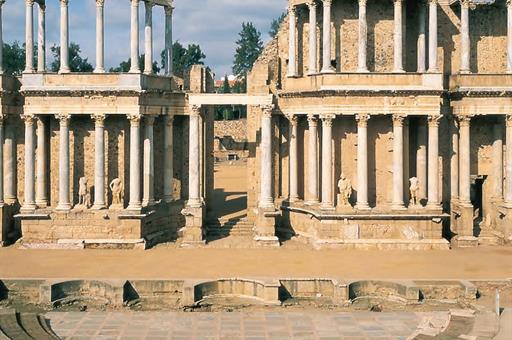Contents
The earliest cultural expressions
The earliest cultural manifestations of any significance are prehistoric. In the Palaeolithic Period, around 15,000 B.C., a Franco-Cantabrian culture stretched from the north of Spain and Europe to Asia. This culture left behind animal figures painted in several caves for magical and religious purposes; the masterpiece from this period can be found in the main chamber of the cave at Altamira, which has been described as the "Sistine Chapel" of cave art.
A later period, the Mesolithic, is represented by the paintings of the Levant school, of African origin, which have been found in primitive shelters ranging from Lleida (Catalonia) to Albacete (Castile La Mancha). These paintings depict humans. During the first millennium B.C., the Balearic Islands witnessed the emergence of a culture of imposing megalithic constructions comprising navetas (burial tombs shaped like the hull of an overturned ship), taulas (T-shaped megaliths) and talayotes (low towers), the most important of which is the Naveta dels Tudons, near Ciutadella on the island of Minorca. Meanwhile, a megalithic culture was developing in Almeria, characterised by dolmens with covered galleries and circular burial chambers, topped by false domes. The most famous example is the Dolmen of Menga, near Antequera (Malaga province).
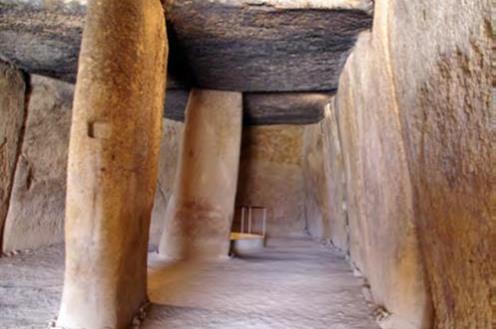 Dolmen of Menga, Antequera (Alejandro Cana, Instituto Nacional de Tecnologías Educativas)Simultaneously, the legendary culture of Tartessus was emerging in the lower Guadalquivir Valley, based on trade with the Phoenician colonies. The Greeks also established colonies along the Mediterranean coast, leaving significant traces of their artistic legacy in areas such as Ampurias (Girona province).
Dolmen of Menga, Antequera (Alejandro Cana, Instituto Nacional de Tecnologías Educativas)Simultaneously, the legendary culture of Tartessus was emerging in the lower Guadalquivir Valley, based on trade with the Phoenician colonies. The Greeks also established colonies along the Mediterranean coast, leaving significant traces of their artistic legacy in areas such as Ampurias (Girona province).
According to all the indications, the large boar sculptures and the bulls at Guisando, near Ávila, are of Celtic origin. The Iberian culture is represented by three sculptures of female figures - the Lady of Elx, the Lady of Cerro de los Santos and the Lady of Baza - that are currently on display at the National Archaeological Museum in Madrid.
The Roman legacy
Romanisation induced the cultural unification of the Iberian Peninsula, leaving not only the language and numerous social institutions but also a plethora of artistic remains. Some of them provide a crucial insight into Roman art, such as the aqueducts in Segovia and Mérida the Alcántara Bridge and the Arch of Bara in Tarragona.
Two splendid Roman complexes can be found at Italica, near the city of Seville, and Mérida, whose splendid theatre is still used to stage classical drama during the summer. Such is the quantity of Roman remains in this town that it was chosen as the site for the National Museum of Roman Art, inaugurated in 1986.
While Rome built the Hispania of the first five centuries, Hispania returned the favour by providing with some of its best sons, including emperors (Trajan and Hadrian), writers and philosophers. This Roman legacy not only pervades numerous institutions but also the law of the land. Similarly, with the exception of Basque, Vulgar Latin served as the root of all the languages of the Iberian Peninsula: Castilian, Catalan, Galician and Portuguese.
The Middle Ages
The generalised spread of Christianity coincided in Spain with the beginning of the Germanic invasion. Little has remained of Visigothic art, which gradually distanced itself from Roman art and fed rather on Byzantine and North African influences. Horseshoe arches, geminate windows sharing a central column, square-shaped apses and barrel vaults are the distinguishing characteristics of the early Christian churches. Two examples can be found in Ourense (Santa Comba de Bande) and Zamora (San Pedro de la Nave).
In the 8th century, Pre-Romanesque art began to emerge in Asturias and reached the height of its splendour during the reign of Ramiro I (the churches of Santa María del Naranco and San Miguel de Lillo).
The Muslim invasion and subsequent Christian reconquest generated a confluence of three cultures - Christian, Islamic and Hebrew - whose fusion and interrelation gave rise to one of the most fruitful processes in European culture.
Meanwhile, the perpetuation of the classical legacy was guaranteed by Alfonso X, who created the Translation School of Toledo and Seville. Alfonso the Wise, as he is also known, is also credited with writing The Seven Divisions of Law and making major contributions to the world of science Lapidarium.
The Arabic tradition also made a lasting impression on the field of poetry, with figures such as Ibn Hazm of Cordoba (The Ring of the Dove) and Ibn Quzman, famed as the inventor of the classical metre. One of the most important philosophers was the great Averroes (1126-98, Cordoba), an Aristotelian scholar.
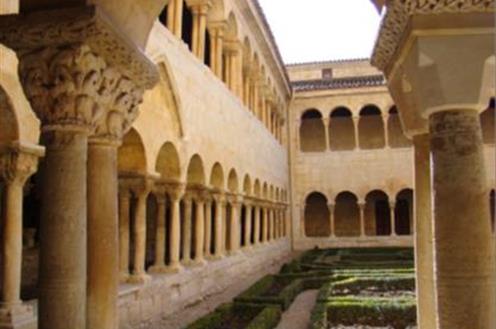 Santo Domingo de Silos Monastery (Carmen Fernández, Instituto Nacional de Tecnologías Educativas)While the field of literature was fertile, the field of architecture was no less. The Great Mosque of Cordoba (begun in 784) and Medina Azahara are outstanding examples of art under the Caliphate. In Seville, the former minaret of the mosque - known as the Giralda - the Golden Tower and the Alcázar palace represent some of the most important monuments of Islamic architecture. The culminating structure from this period is the magnificent Alhambra palace in Granada.
Santo Domingo de Silos Monastery (Carmen Fernández, Instituto Nacional de Tecnologías Educativas)While the field of literature was fertile, the field of architecture was no less. The Great Mosque of Cordoba (begun in 784) and Medina Azahara are outstanding examples of art under the Caliphate. In Seville, the former minaret of the mosque - known as the Giralda - the Golden Tower and the Alcázar palace represent some of the most important monuments of Islamic architecture. The culminating structure from this period is the magnificent Alhambra palace in Granada.
Although the Arabic presence persisted in the south, the north of Spain maintained close contact with the prevailing European culture thanks to the Pilgrim Way of St. James, which ends at the tomb of the apostle in Santiago de Compostela. Along the way, churches were built in which European Romanesque art blended with the Pre-Romanesque style typical of Spain. Examples of this are the cathedral in Jaca (Huesca province), the church of San Martín de Frómista in Palencia, the beautiful frescoes in the royal pantheon at the Basilica of San Isidoro in Leon, and the great cathedral in Santiago de Compostela, whose sculptures adorning the Pórtico de La Gloria portal are regarded as the masterpiece of Spanish Romanesque art.
Romanesque painting can be observed in the frescoes, and the art of drawing developed in illuminated manuscripts (Beato de Liébana, Beato de Girona).
Sculpture acquired a distinct physical identity in the 11th century, which was mainly manifested in the cloister of Santo Domingo de Silos (Burgos), the royal pantheon and the portals of the Basilica of San Isidoro (Leon), the capitals in the cathedral of Jaca (Huesca), the monastery at Ripoll and the mentioned cathedral of Santiago.
Other noteworthy Romanesque monuments can be found in the region of Castile and Leon (Avila, Zamora, Soria, Salamanca, Segovia, Burgos), while Navarre, Aragon and Catalonia all boast magnificent churches with superb paintings. Nowadays, most of these are held at the National Art Museum of Catalonia in Barcelona.
During this period - the 12th century - Castilian began to develop as a literary language with the publication of the first great epic, The Lay of the Cid.
Gothic art first emerged in Spain during the 13th century in the old Cistercian style, as evidenced in the monasteries of Las Huelgas in Burgos and Poblet in Tarragona, and achieved its finest expression in the cathedral of Leon. The 14th century was characterised by the emergence of the Catalonian Gothic style (cathedrals of Barcelona, Girona and Palma, Majorca) and the 15th century by the Late or Flamboyant Gothic style (cathedrals of Seville, Toledo and Burgos). Civil architecture also began to develop during this period, notable examples of which are the shipyards in Barcelona and the old markets in Valencia and Palma, Majorca.
In the field of literature there were important advances, with popular minstrel verses giving way to more learned poetry. Gonzalo de Berceo is the earliest known Spanish poet, famed for his work The Miracles of Our Lady.
Alfonso X has already been cited in connection with his Siete Partidas, but he also wrote the Crónica General, the first history of Spain, and the Songs to the Virgin Mary in Galician. It was also during his reign that the first collections of stories appeared such as The Eastern Fables of Kalilag and Damnag as well as the first dramatic script, Play of the Three Wise Men.
The Renaissance
The 14th century was an extraordinarily fruitful period with profound influences from Italian humanism on literary works such as Book of Good Love, by the Archpriest of Hita, Count Lucanor, by Alfonso X's nephew, Juan Manuel and Chronicles and Rhymes of Palace Life by Pedro López de Ayala.
In the following century, literature adopted a more lyrical and courtly form, paving the way for the ideological transition between medieval and Renaissance ideals that took place at the beginning of the Modern Era, which spans the period from the last decade of the 15th century to the end of the 18th century. The main figures of this period were the Marquis of Santillana (1398-1458), who was the first person to use the sonnet in Spain, and Jorge Manrique with his Coplas por la muerte de mi padre (Verses on the Death of My Father).
In the field of architecture, the combination of Spanish Gothic and Italian Renaissance produced the hybrid Plateresque style, exemplified by the universities of Alcalá de Henares and Salamanca which were both built during this period. Meanwhile, consolidation of Castilian Spanish came with the publication Arte de la lengua castellana (Art of the Castilian Language), the first grammar text applied to a vulgar language. The first chivalrous novels also emerged at this time, including the famous Amadis of Gaul.
A similarly notable evolution took place in the genre of drama. Juan de la Encina (1469-1529) was the first to write about nonreligious themes, but the genuine breakthrough came with The Celestina or the Tragic Comedy of Calisto and Melibea by Fernando de Rojas, the second most important work in Spanish literature after Don Quixote.
The Golden age
Chronologically situated mid-way between the Renaissance and the Baroque, the Spanish Golden Age (16th-17th centuries) was a glorious flourishing of the arts and letters in Spain.
During this period the novel achieved its finest Spanish and universal expression with Don Quixote by Miguel de Cervantes, and several other distinctly Spanish genres emerged, such as the picaresque novels Guzmán de Alfarache by Mateo Alemán and the anonymous Lazarillo de Tormes.
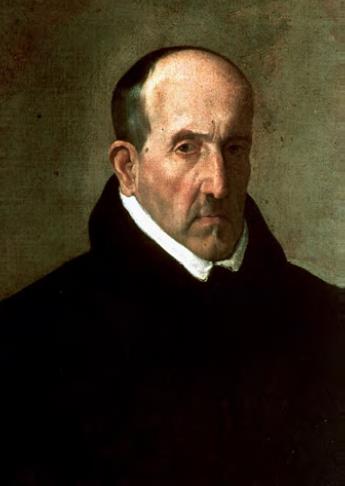 "Luis de Góngora" by Velázquez (Instituto Nacional de Tecnologías Educativas)Poetry evolved at the same pace. In the 16th century Boscán and Garcilaso de la Vega adapted Italian metres to the Spanish language; the finest expression of this style can be found in the mystical works of Fray Luis de León and St. John of the Cross, and in the prose of St. Theresa of Ávila. Two great figures from this period are Luis de Góngora and Francisco de Quevedo.
"Luis de Góngora" by Velázquez (Instituto Nacional de Tecnologías Educativas)Poetry evolved at the same pace. In the 16th century Boscán and Garcilaso de la Vega adapted Italian metres to the Spanish language; the finest expression of this style can be found in the mystical works of Fray Luis de León and St. John of the Cross, and in the prose of St. Theresa of Ávila. Two great figures from this period are Luis de Góngora and Francisco de Quevedo.
Major changes were also afoot in the field of drama. Instead of being staged in ecclesiastical settings, plays were now performed in open-air public places such as the so-called Corrales de Comedias, still used today in Almagro (Ciudad Real province). This form of artistic expression achieved unprecedented splendour in the works of Lope de Vega, Tirso de Molina and Calderón de la Barca.
Humanism also flourished from early on in the Modern Era, thanks to figures such as the philosopher Luis Vives and monumental collaborative works such as the Complutensian Polyglot Bible.
As a final note on the literature of the Spanish Golden Age, the period closed in the 17th century with Baltasar Gracián's The Faultfinder.
In the field of painting, the 16th century produced an outstanding artist in the figure of Domenikos Theotokopoulos, "El Greco", who worked mainly in Toledo. His canvases The Disrobing of Christ, Martyrdom of St. Maurice, The Resurrection and The Burial of Count Orgaz are all landmarks of Spanish and universal painting.
The realism of the 17th century found its finest exponent in Diego Velázquez (1599-1660), whose main works are as follows: Las Meninas (a.k.a. The Maids of Honour), The Surrender of Breda, The Forge of Vulcan, and his famous portraits Philip IV, The Prince Baltasar Carlos and the Count-Duke of Olivares. Most of these works hang in the Prado Museum.
While Velázquez was painting in Madrid, Zurbarán and Murillo were busy in Seville, producing paintings with predominantly religious themes.
The Golden Age is also credited with a specific architectural style named after Juan de Herrera. The finest example of the style is the Royal Monastery of San Lorenzo de El Escorial, commissioned by Philip II.
Of Italian origin, from whence comes its name, the Baroque style embodies the spirit of the Counter- Reformation. It is mainly a decorative style based on fanciful, over-elaborate forms.
The Society of Jesus stamped the Baroque style on all religious monuments from previous periods, superimposing it onto designs originally in the Gothic and even Romanesque styles.
The most outstanding examples in Spain are the façade of the Hospicio de San Fernando in Madrid, the Palace of San Telmo in Seville, the Obradoiro portal in Santiago de Compostela, the Jesuit Shrine of Loyola, the façade of the University of Valladolid and the Basilica of Nuestra Señora del Pilar in Saragossa.
The age of Enlightment
The 18th century, known in Spanish as El Siglo de las Luces or the Century of Lights, witnessed the introduction of the spirit of the Enlightenment and with it education, science, public works and a rational concept of politics and life.
The reign of Philip V ushered in the foundation of new cultural institutions such as the Royal Library (subsequently renamed the National Library) and the Academy of the Spanish Language, both in 1714. These were followed twenty years later by the academies of Medicine, History, Pharmacy and Law, as well as the Academy of Fine Arts of San Fernando.
Science received an enormous boost with the creation of the Cabinet of Natural History, the Botanical Gardens, the School of Mineralogy, the Cabinet of Machines in the Retiro, the Royal Laboratory of Chemistry and several Schools of Engineering.
The political and satirical press flourished, along with the publication of cultural and scientific articles. Although in the literary field the quality was substantially inferior to that of two centuries earliers. The main poets of the period were Cadarso, Nicasio Gallego and Alberto Lista. Finally, in the field of letters, the 18th century was noted for two great figures - Father Feijoo and Jovellanos.
In architecture, the Baroque style gave way to Neoclassicism. The Bourbons brought numerous foreign artists to Spain and Charles III commissioned major public infrastructure works. Ventura Rodríguez and Juan de Villanueva were the most important Spanish architects of this period, renowned for creations such as the Royal Palace, the Prado Museum and the Alcalá Gate, all in Madrid.
By contrast, painting experienced a period of decline. The Spanish and international painters commissioned to decorate the palaces were all of mediocre quality. Finally, however, in the final decade of the century, one the greatest painters of all time emerged: Francisco de Goya. Regarded as the father of all the "isms", Goya painted a vast range of works, including light-hearted cartoons for the Royal Tapestry Factory, macabre etchings such as The Disasters of War, the bitter Caprichos, the Follies and the Tauromachia, and dramatic paintings such as The Third of May 1803 and the frescoes of San Antonio de la Florida in Madrid.
Romanticism
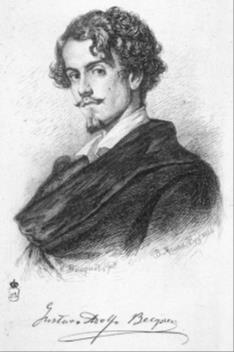 G. A. Bécquer (Biblioteca Digital Hispánica)Romanticism, the artistic and literary expression of liberal thinking, arrived late in Spain (it had its heyday between 1830 and 1840) and with a distinctly French flavour. Its main exponent was Mariano José de Larra (1809- 1837), whose influence continued into and well beyond the second half of the century in the poetry of Gustavo Adolfo Bécquer (1836- 1870) and the plays of the first Spanish recipient of the Nobel Prize for Literature: José Echegaray.
G. A. Bécquer (Biblioteca Digital Hispánica)Romanticism, the artistic and literary expression of liberal thinking, arrived late in Spain (it had its heyday between 1830 and 1840) and with a distinctly French flavour. Its main exponent was Mariano José de Larra (1809- 1837), whose influence continued into and well beyond the second half of the century in the poetry of Gustavo Adolfo Bécquer (1836- 1870) and the plays of the first Spanish recipient of the Nobel Prize for Literature: José Echegaray.
Romanticism was succeeded by the costumbrista works of Mesonero Romanos, the poetry of Espronceda and the dramatic scripts of the Duke of Rivas and José Zorrilla.
In the second half of the 19th century, the romantic exaltation of national values fuelled a revival of Spain's regional cultures. In Catalonia this led to the restoration of the Jocs Florals (the Floral Games poetry contest) and ushered in the so-called Catalonian Renaissance with the works of Rubio i Ors, Verdaguer and Guimerá.
Romanticism also inspired the flourishing of Galician literature, whose two key figures were Rosalía de Castro and Curros Enríquez. In the final third of the century, a counterpart to the Romantic Movement emerged in the form of the more or less costumbrista realism of Fernán Caballero, Alarcón and Pereda. However, the two great figures of this period were Juan Valera and Benito Pérez Galdós. Considered the father of the contemporary Spanish novel, Galdós created a gigantic historical novel world in his National Episodes. His work paved the way to Naturalism, which was embodied by three great figures: Leopoldo Alas "Clarín", Emilia Pardo Bazán and Vicente Blasco Ibáñez.
The Generation of 1898 and 1927
The late 19th century was a hotbed of political, literary, philosophical, artistic and scientific analysis. The institutions that had been founded at the beginning of the century - the Ateneos or athenaeums (cultural centres inspired by classical Athens and devoted to humanist values and freethinking) and artistic and literary academies - came into their own, and Joaquín Costa and Giner de los Ríos launched a movement of national revival. The outstanding figures in the field of historical research were Amador de los Ríos, Menéndez Pidal, Rafael Altamira, Milá and Fontanals, while Marcelino Menéndez Pelayo was the key figure in the context of traditional thinking.
Scientific research began a slow recovery, especially in the field of medicine, with figures such as Jaime Ferrán, Pío del Río Hortega and the future Nobel Prize winner, Santiago Ramón y Cajal.
Despite the political and social unrest in Spain during the first third of the 20th century, literary creation experienced a glorious revival that some analysts have called a Silver Age, spanning the period between 1898 and the outbreak of the Spanish Civil War in 1936.
The first of these dates marks the loss of the last Spanish colonies and, in general, the end of a decline initiated in the 17th century.
A large group of writers reacted to this event by exploring its causes and proposing their own remedies for the regeneration of Spain. Together they formed the so-called Generation of '98 which, although it included great literary figures, transcended the field of literature to encompass science, medicine, history and the essay genre.
At the same time, Modernism was emerging. A contemporary of pictorial and musical Impressionism, this movement was particularly important in Catalonia, which has always been more open to the winds of change blowing in from Europe. Its main exponent was the genius architect Antonio Gaudí, and it was also linked to the Renaixença (Renaissance) of Catalonian culture based on the prosperity of an educated industrial class increasingly open to regionalist ideas. The unique style of Gaudí is replete with plant and animal evocations in groundbreaking works such as the incomplete Church of La Sagrada Familia and the fantastic gardens of the Parque Güell. This same Modernisme, as the movement was known in Catalonia, eventually produced the extraordinary painter Pablo Picasso.
.%20Antoni%20Gaud%C3%AD.jpg?RenditionID=5) "La Pedrera" by Antoni Gaudí (Turespaña)The late 19th century in Spain was also characterised by the arrival of echoes of the musical nationalism that had spread throughout Europe. Two Spanish composers achieved international recognition in this field: Isaac Albéniz and Enrique Granados.
"La Pedrera" by Antoni Gaudí (Turespaña)The late 19th century in Spain was also characterised by the arrival of echoes of the musical nationalism that had spread throughout Europe. Two Spanish composers achieved international recognition in this field: Isaac Albéniz and Enrique Granados.
In painting, Ignacio Zuloaga's works, with their emphatic drawings and typically Spanish characters, expressed a certain affinity with the literary world of the Generation of '98. Meanwhile, the Valencian artist Joaquín Sorolla can be described as a colourful Post-Impressionist; beneath the anecdotal surface of his canvases, the unique light of the eastern shores of Spain is the true protagonist of his beach scenes.
The Generation of '98 - preoccupied almost to the point of obsession with what began to be known as "the problem of Spain" - orchestrated a brand-new style that had little in common with the characteristic rhetoric of the 19th century.
Some of the representatives of this trend achieved a genuinely universal stature. Such is the case of Miguel de Unamuno, who cultivated all literary genres and whose work The Tragic Sense of Life in Men and Peoples was a precursor of Existentialism. Another great figure was his contemporary Pío Baroja, a renowned novelist who was much admired by Hemingway. Azorín, famed for his masterful skill as a narrator, and Ramón María del Valle-Inclán, who invented esperpento or the theatre of the grotesque, were also crucial figures of this movement.
In the poetry field, the main figures are Antonio Machado, whose works combine symbolism and social reflection, and Juan Ramón Jiménez, another Nobel laureate, whose poems evolved from a kind of sentimentality to a much deeper, abstract and complex lyricism.
A common trait shared by all intellectuals during this period was the attempt to incorporate the latest trends in European culture and thinking. The philosopher Ortega y Gasset founded the magazine Revista de Occidente, one of the first intellectual publications in Europe at the time. Ramón Pérez de Ayala's essays and novels expressed the liberal spirit of the British, while Eugenio d'Ors added a whole new slant to the criticism of Baroque art.
Nearly all of these authors contribute regularly to the press, which they use as vehicles of dissemination and cultural pedagogy in an attempt to renew national sensitivity and promote an open attitude towards European modernity.
In the 1920s, the refreshing winds of the aesthetic vanguards blew strongly in Europe and a group of universal figures emerged - Pablo Picasso, Salvador Dalí and Luis Buñuel. Picasso sought his inspiration in Hispanic roots and in the extravagant, Baroque and highly contrasting temperament that seems to characterise Spanish art, developing a Cubist style that has gone down as the first page in the history of 20th-century painting.
Other major influences on contemporary painting were Juan Gris, who succeeded in reducing objects to their chromatic masses and basic geometries, and Joan Miró, the Surrealist master whose profoundly poetic and original works reveal an apparently childlike yet incredibly astute vision. Another figure tied to the Surrealist movement was the painter Salvador Dalí, highly skilled in the art of drawing and with a fondness for using calculated gestures to shock bourgeois tastes. During the 1920s Dalí had lived with Luis Buñuel and Federico García Lorca at the Residencia de Estudiantes in Madrid. This institution, famed for its intellectual atmosphere and for promoting great artistic sensitivity amongst its occupants, has survived to this day under the protection of the Higher Council of Scientific Research.
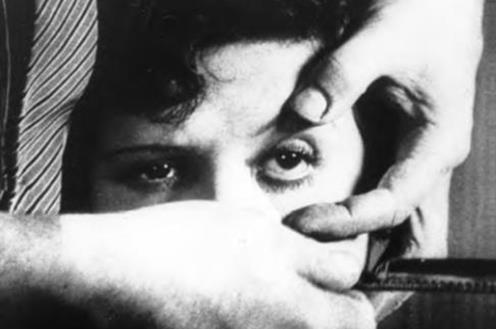 "Un Chien Andalou" by Luis Buñuel (Filmoteca Española)Except for in the early 17th century, Spain had never known such a simultaneous emergence of poetic talent as that embodied by Jorge Guillén, Pedro Salinas, Federico García Lorca, Rafael Alberti, Nobel laureate Vicente Aleixandre, Luis Cernuda, Dámaso Alonso and Gerardo Diego. Culturally, the Generation of '27 represents a unique moment in time when the vanguard movements, an enthusiasm for modern art, and the European optimism of the interwar period all joyfully combined and acted as the prevailing influences.
"Un Chien Andalou" by Luis Buñuel (Filmoteca Española)Except for in the early 17th century, Spain had never known such a simultaneous emergence of poetic talent as that embodied by Jorge Guillén, Pedro Salinas, Federico García Lorca, Rafael Alberti, Nobel laureate Vicente Aleixandre, Luis Cernuda, Dámaso Alonso and Gerardo Diego. Culturally, the Generation of '27 represents a unique moment in time when the vanguard movements, an enthusiasm for modern art, and the European optimism of the interwar period all joyfully combined and acted as the prevailing influences.
Young creators would enthusiastically embrace the world of cinema, the "city lights", the break with bourgeois values and realist art, and the dream of an aesthetic and political revolution.
Years later, they all fell victim to the tremendous divide created by the Spanish Civil War. Federico García Lorca was executed, and Rafael Alberti, Luis Cernuda, Pedro Salinas, Jorge Guillén, Rosa Chacel and María Zambrano were all forced into exile. The poetry of this generation, which had imbued the genre in Spain with the ideal of perfection, of "pure poetry," became worldlier and more pensive.
The same fertile atmosphere of the Residencia de Estudiantes also produced the Aragonese film-maker Luis Buñuel, who worked from his exile in Paris to carve out a place for himself in the international arena. Temporally connected to the Surrealist movement, his work possesses a corrosive strength and critical violence that bear certain similarities to the pictures of his fellow countryman, Francisco de Goya.
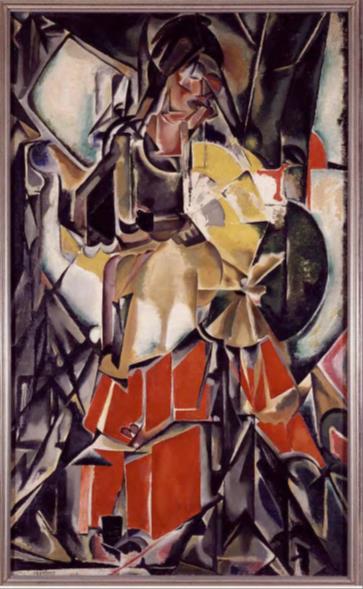 "Mujer con abanico" by María Blanchard (J. Cortés y R. Lores, Museo Reina Sofía)Another important figure at this time was the Catalonian musician Pau Casals, a worldclass cello player and tireless defender of the republican cause and Catalonian nationalism. His famous versions of Bach's suites occupy their own place in the history of contemporary musical performance. Meanwhile, Spanish cultural nationalism was embodied by Manuel de Falla; thanks to his work, flamenco music - the spontaneous expression of popular Andalusian vocal music - first gained recognition as a sophisticated art form.
"Mujer con abanico" by María Blanchard (J. Cortés y R. Lores, Museo Reina Sofía)Another important figure at this time was the Catalonian musician Pau Casals, a worldclass cello player and tireless defender of the republican cause and Catalonian nationalism. His famous versions of Bach's suites occupy their own place in the history of contemporary musical performance. Meanwhile, Spanish cultural nationalism was embodied by Manuel de Falla; thanks to his work, flamenco music - the spontaneous expression of popular Andalusian vocal music - first gained recognition as a sophisticated art form.
The new vanguard movements also influenced Spanish sculpture. Lesser known than Picasso and Dalí but equally deserving of their place in the history of contemporary art are the sculptors Julio González, Pablo Gargallo and Alberto Sánchez.
Spanish drama also flourished in the first third of the 20th century, especially thanks to the work of Jacinto Benavente, yet another Spanish recipient of the Nobel Prize for Literature.
As a counterpart to this high drama, musical and non- musical farce became the most important popular genre. This form of simple, costumbrista and sentimental drama focused in particular on the daily life of the Andalusian working classes (embodied in the works of the Álvarez Quintero brothers). The plays written by Arniches feature a similar idea, although he used an original and highly appealing formula - grotesque tragic comedy, combining both comedy and pathos.
But Spanish drama of the 20th century was marked by two great authors: Valle-Inclán and García Lorca. Although both reacted against conventional, bourgeois, naturalist drama, García Lorca explored the poetry of drama and a new style of tragedy, while Valle-Inclán developed a brand new device: esperpento, or grotesque drama. In his works, the heroes and princesses are all refl ected in concave and convex mirrors, producing a deformation or caricature of reality in keeping with the author's conviction that Spain at the time was a deformation of Europe.
The works of García Lorca transcend Andalusian folklore to encompass the mythical roots of all human beings: passion, sterility, society that thwarts human fulfilment.
From the post-war period to the present day
Due to the situation created by the Civil War, numerous intellectuals opted to go into exile. This, in addition to the limitations imposed by the new regime, gave rise to a cultural parenthesis from which Spain was slow to recover. However, from their exile abroad, people such as Francisco Ayala, Ramón J. Sénder, Max Aub, Gil Albert and Pau Cassals worked unstintingly to promote Spanish culture.
Meanwhile, in Spain itself a dual movement emerged. Some intellectuals embraced the political ideals of Franco's regime, while others pursued their intellectual or artistic activities as a form of opposition.
Poetry abandoned the aesthetic ideals embodied by Luis Rosales and Leopoldo Panero in favour of either the social realism of figures such as Blas de Otero, Gabriel Celaya, José Hierro and Carlos Bousoño, or the reassertion of nationalist or avant-garde movements, represented by Salvador Espriu, the Novísimos (a group of innovators led by Barral, Castellet) and others.
The work of the Generation of '27 remains as valid as ever, and in 1977 Vicente Alexandre was awarded the Nobel Prize for Literature. Twelve years later, in 1989, the same prize was awarded to Camilo José Cela.
Meanwhile, in the 1940s the creation of the national theatres brought together a series of authors who managed to overcome the restrictions imposed by the regime and develop a type of drama open to new trends emerging around the world. Antonio Buero Vallejo and Alfonso Sastre were instrumental in breathing new life into Spanish drama.
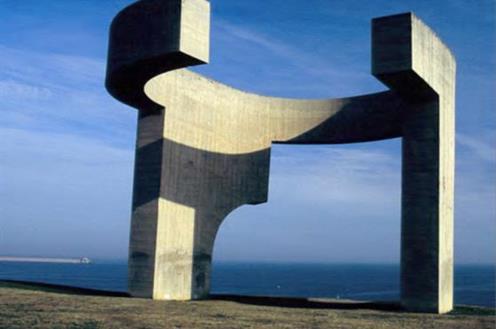 "Elogio del horizonte" by Eduardo Chillida (Carlos Romero, Instituto Nacional de Tecnologías Educativas)The novel also recovered slowly and adopted life under Franco as its central theme. This is particularly evident in works such as Camilo José Cela's The Hive and Luis Martín Santos's Time of Silence. "Other important novelists included Gonzalo Torrente Ballester, Miguel Delibes, Carmen Laforet, Sánchez Ferlosio, Fernández Santos and Juan Goytisolo.
"Elogio del horizonte" by Eduardo Chillida (Carlos Romero, Instituto Nacional de Tecnologías Educativas)The novel also recovered slowly and adopted life under Franco as its central theme. This is particularly evident in works such as Camilo José Cela's The Hive and Luis Martín Santos's Time of Silence. "Other important novelists included Gonzalo Torrente Ballester, Miguel Delibes, Carmen Laforet, Sánchez Ferlosio, Fernández Santos and Juan Goytisolo.
In the 1970s Juan Benet renewed the literary scene, and the following decade witnessed the emergence of writers such as Javier Marías, Muñoz Molina and Pérez Reverte, whose works acquired an unprecedented international importance and readership.
In the visual arts, there was a move towards pictorial abstraction (embodied by Tápies, Saura, Canogar, Millares and Guinovart), which subsequently gave way to the critical realism of Genovés and Pop Art (Equipo Crónica). In recent years, Antonio López has consolidated the sure merits of his radical realism and Miquel Barceló's creativity has triumphed in the temples of contemporary art. In the field of sculpture, the study of forms and volume is a constant in the work of artists such as Chillida and Oteiza.
Over a period of three decades (1940- 1970), Spanish film attained unprecedented heights of fame. The "imperial films" promoted by CIFESA gradually gave way to the refreshing approach of Bardem and Berlanga and Saura and Buñuel's later work.
At the beginning of the 1990s, the Spanish film industry was rejuvenated by a generation of young directors such as Pedro Almodóvar, Fernando Trueba and most recently Alejandro Amenábar, all of whom are currently in their professional prime and have won international acclaim.





